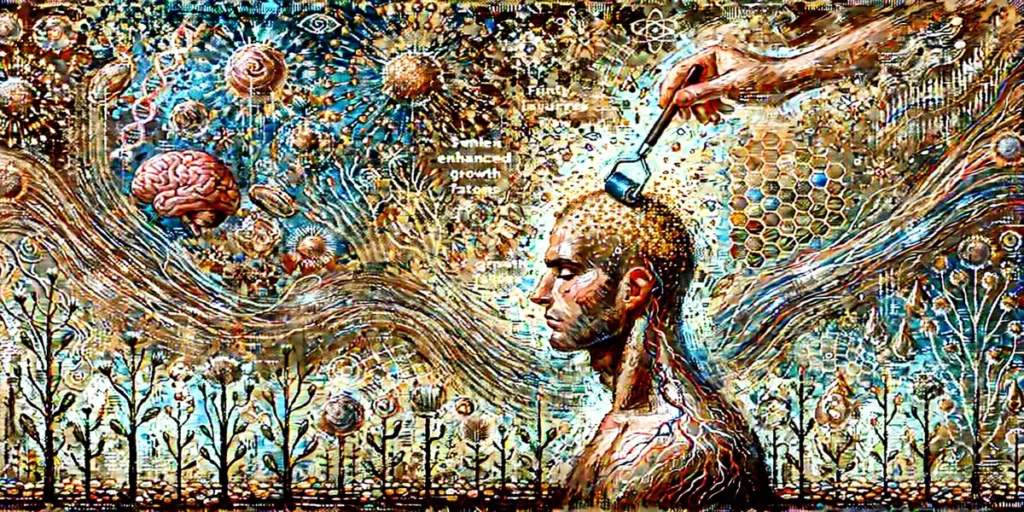Microneedling sounds a bit futuristic, but don’t worry, it’s more about tiny pokies than sci-fi tech. Essentially, we’re looking at a technique where multiple tiny, sterilized needles are used to puncture the skin. It’s kind of like aerating your lawn to make the grass grow thicker, but for your scalp.
The magic happens beneath the surface. When these needles glide over the skin, they create minuscule wounds. Your body jumps into action, rushing growth factors and collagen to the scene to heal the area. This boost in collagen not only revitalizes the skin but also enhances blood circulation directly to your hair follicles.
Now, this isn’t just about repairing the skin. The increased circulation and collagen have a two-pronged effect: they help wake up latent hair follicles and promote new hair growth. Think of it as giving your scalp a workout and a spa day all in one.

The tools of the trade can vary, but you’ll typically see something called a dermaroller or a microneedling device involved. These gadgets are your frontline soldiers in the battle against hair thinning. Just roll them over your scalp, and let them do their thing—carefully, of course. No need for Jedi skills, just a steady hand and the right equipment.
Microneedling is a pretty nifty concept that taps into the body’s natural ability to heal. It’s not about pulling a rabbit out of the hat but more like coaxing your body to bring its best game to your scalp.
🧬 Science Meets Hair: How Microneedling Can Stimulate Hair Growth
When it comes to hair growth, science has more up its sleeve than just shampoos and potions. Microneedling gives your scalp a little wake-up call, and here’s the lowdown on how that works.
Let’s dive into the world of micro-trauma. When those tiny needles pierce the skin, they are creating micro-traumas—sounds intense, but hang tight. These controlled injuries are what get the body’s repairmen—like proteins, stem cells, and growth factors—rushing to the scene.
Among these handy helpers, growth factors are the real MVPs in your hair’s natural game plan. These factors are like tiny messengers that tell your cells to get cracking on generating new, healthier hair. They’re a key player in jumpstarting dormant hair follicles, essentially nudging them to start the hair production process.
You might wonder, is this method backed by science? Absolutely! Numerous studies, including the 2013 one by Dhurat et al., highlight how microneedling enhances the scalp environment to support robust hair growth. In a nutshell, your body already knows how to grow hair, and microneedling just gives it a little nudge in the right direction.

Results don’t happen overnight, though. Typically, you’ll see changes over several months as those follicles need time to respond. Patience and persistence are crucial, but when combined with consistency, microneedling turns into a valuable ally in your hair growth journey.
📚 Is Microneedling Scientifically Backed? A Look at Key Studies
Everyone’s got an opinion on whether microneedling truly works for hair growth, but let’s get into what the science actually says. Peer-reviewed studies are our best friends here, offering hard data and results that make a solid case for this treatment.
The Dhurat et al. 2013 study often sits at the top of the list. In this study, participants who used microneedling along with minoxidil saw a dramatic increase in hair count compared to those using minoxidil alone. Specifically, those adding microneedling boasted hair counts of 91 hairs per cm², in contrast to just 18 hairs per cm² with minoxidil alone. Even the biggest skeptics can’t argue with those numbers!
This isn’t the only study out there, though. Various research papers reiterate how microneedling fosters an enriched environment for hair regrowth. Besides boosting growth factor production, microneedling was shown to facilitate the penetration of topical treatments, somewhat like opening a gate that allows products to penetrate deeper into the skin for maximized efficacy.
So, is microneedling just a hype train? According to the science so far, it’s not. But remember, individual results can vary, and it’s always wise to consult with a healthcare professional before starting any treatment. Sound science provides a foundation, but personalized advice is the final piece of the puzzle.

With the scientific backing in mind, microneedling stands as a promising option for those looking to invigorate scalp health and boost growth. If you’re gearing up to give it a go, just be sure you’re armed with comprehensive knowledge and the right tools.
🌿 How To Maximize Your Microneedling Results: A Holistic Approach
While microneedling is a powerful tool, the best results come when it’s part of a broader hair care strategy. If you want to truly support your scalp and hair growth, here’s what the experts (and your follicles) recommend:
- Eat like your hair depends on it: A diet rich in protein, iron, zinc, and B vitamins helps provide the raw materials for healthy hair. Hair is made of keratin—a protein—so don’t skip the good stuff.
- Stress is a silent strand killer: Chronic stress raises cortisol, which can shorten the hair growth phase. Managing stress isn’t optional—your scalp literally feels your emotions.
- Avoid polluted environments: Air pollution can inflame the scalp and damage follicles over time. Your hairline deserves better than a smog sandwich.
- Ditch the smoke: Smoking reduces blood flow to the scalp and bombards your body with toxins, weakening the hair from root to tip.
To speed things up and support the process, consider:
- Hair growth supplements: Biotin, saw palmetto, silica, and marine collagen can help fuel the follicles.
- Anti-stress supplements: Adaptogens like ashwagandha or Rhodiola rosea can help keep cortisol levels in check—great for both mind and mane.
- Low-level laser therapy (LLLT): Laser caps or combs stimulate follicles with red light—safe, science-backed, and increasingly popular.
- Gentle shampoos and repairing conditioners: Harsh cleansers strip the scalp; opt for products that nourish instead of attack.
When combined, these factors can amplify the benefits of microneedling. Because let’s be real: hair health doesn’t come from needles alone—it’s a lifestyle thing.
🎯 Tailoring Solutions: Who Can Benefit from Microneedling?
Diving into the world of hair loss can sometimes feel like wading through a sea of options and opinions. It’s crucial to understand who stands to benefit the most from microneedling before rolling that dermaroller on your scalp.

Different types of hair loss swing by for various reasons. Androgenetic alopecia, more commonly known as male or female pattern baldness, is a prime candidate for microneedling treatment. By reinforcing scalp health through stimulated blood flow and collagen production, this treatment has shown promise in tackling hereditary hair loss.
But pattern baldness isn’t the only hair hurdle microneedling can address. Temporary hair loss resulting from stress or postpartum issues can also see improvements. The trick is in how microneedling encourages a more fertile ground for hair regrowth, regardless of whether the hair loss is permanent or temporary.
It’s not a one-size-fits-all miracle though. Folks with active scalp conditions or infections should steer clear until given the green light by a healthcare professional. If you’re employing other treatments like minoxidil, consulting with a doctor is key to ensuring safety and efficacy.
The takeaway? Microneedling presents a versatile option for many experiencing hair loss. However, individual assessment and professional advice are essential as they help you blend the science with what specifically suits you. Tailoring the treatment to your unique situation maximizes the chances of seeing those strands regain their glory.
🛡️ Safe Practices: How to Do Microneedling at Home and In Clinics
Ready to take microneedling into your own hands? Whether you’re opting for a DIY approach or leaning on professional expertise, safety should sit at the top of your checklist.
Let’s chat about doing it yourself. If you decide to go the at-home route, it’s all about having the right equipment and a sound approach. Invest in a high-quality dermaroller, ideally with needles between 0.5mm to 1.5mm for scalp use. This size strikes a nice balance for penetrating the scalp without going overboard.
How often should you microneedle? Allow your scalp some breathing room between sessions—once a week usually hits the sweet spot for most folks. But remember, it’s not a race—consistency beats frequency when it comes to encouraging hair growth.

Hygiene is your best friend here. Clean your roller with isopropyl alcohol before and after every use to keep infections at bay. And don’t skip on skin prep either; a clean scalp makes a great canvas for microneedling.
Thinking about leaving it to the pros instead? Professional treatments bring the benefit of expertise and advanced equipment, not to mention the peace of mind that a trained technician offers. They’re generally pricier but often bring quicker, more noticeable results.
Whether at home or in a clinic, knowing how to avoid potential side effects like redness or irritation keeps you in the safety zone. Arm yourself with knowledge and good practices, and you’ll be setting the stage for positive results. Whichever path you choose, a mindful approach ensures your microneedling journey is both safe and effective.
So, is microneedling the miracle cure for hair loss? Not quite. But is it a powerful, science-backed strategy that can help you reclaim your hairline? Absolutely.
If you’re patient, consistent, and smart about how you care for your scalp—microneedling can become a game-changer. Especially when it’s supported by the right nutrition, stress management, gentle hair care, and smart supplementation.
Remember: hair health isn’t about chasing magic. It’s about doing the small, right things often enough to let biology do its work.

❓ FAQ: Microneedling and Hair Growth
🎯 How does microneedling help with hair growth?
Microneedling creates micro-injuries in the scalp, which stimulate collagen production, boost blood flow, and increase the absorption of topical treatments like minoxidil.
🧴 Can I use minoxidil or other products after microneedling?
Yes — applying minoxidil, peptides, or growth serums after microneedling can enhance their penetration. Just wait at least 12–24 hours to avoid irritation.
🩸 How often should I microneedle my scalp?
For hair growth, once a week is a common recommendation. Using 0.5–1.5 mm needles is typical, but frequency should be adjusted based on skin sensitivity.
⚠️ Is microneedling safe for everyone?
It’s generally safe, but avoid it if you have scalp infections, active acne, eczema, or poor wound healing. Always disinfect the roller and consult a professional if unsure.
🧾 Last updated: June 2025 based on dermatology research and clinical trials.


Leave a Reply